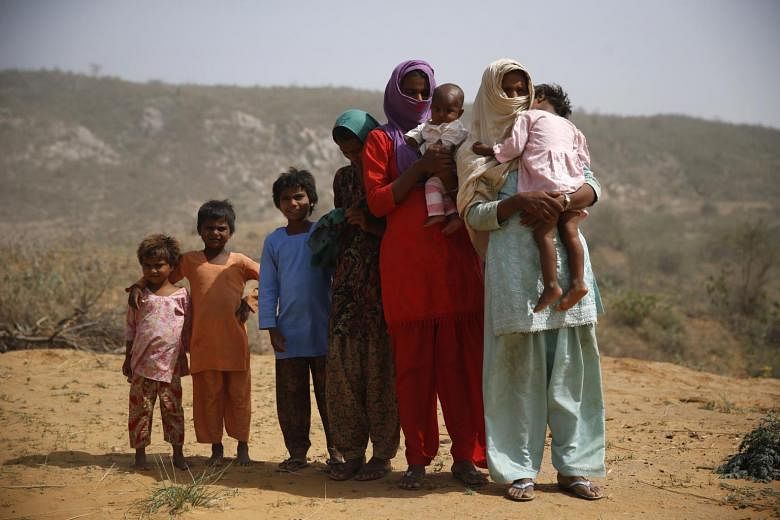In the run-up to India's general election in April last year, bachelors in the small village of Bibipur in northwestern Haryana state rallied together and threw the candidates a curveball: Find us brides, and get our votes.
Aggressive female foeticide has left Haryana with the country's most warped sex ratio at birth. Male youth were coming of age to realise there were no women to marry, and were left with a few unpalatable options - buy a bride or stay single for the rest of their lives.
The Bibipur bachelors were not the first to demand brides for votes. In 2009, a Haryana man called Pawan Kumar set up a bachelors' union to demand jobs and brides in exchange for electoral support.
Such scenarios reinforce increasing panic about Asia's growing sex imbalance; about how tens of millions of involuntary bachelors - mostly in India and China - could form a restive mass that is unpredictable on the streets and at the ballot box
There is much fear and stereotype woven into narratives about Asia's surplus men - borne out of a cultural bias for sons, controversial population-control measures, technological advances that made it easy to identify and abort female foetuses. India's 2011 census found that there were 35.7 million more men than women. In China, that figure was 33.8 million in 2013.
During the past decade or so, several studies have drawn, or attempted to draw correlations between the abnormal sex ratios and violence and other crimes in China.
United States- and Britain-based scholars Valerie Hudson and Andrea Den Boer, in their 2004 book Bare Branches: The Security Implications of Asia's Surplus Male Population, warned that the subclass of young men with the lowest socioeconomic standing and little chance of forming their own families are more prone to violent and criminal behaviour. Their governments might tend towards a more authoritarian mode of governance as a result, they said.
In 2007, a team of US- and China-based scholars led by Lena Edlund published a paper that found a correlation between higher sex ratios and the incidence of violent and property crime like robbery and theft.
Other scholars are predicting subtler repercussions. Professor Yuan Xin, from Nankai University's Institute of Population and Development Research, told my colleague Kor Kian Beng: "The stability of the family structure may face threat as these men may target married women."
Meanwhile, "there are questions over whether sex crimes such as rape would rise," he said. "These men have their biological needs."
These same sentiments were implied by some commentators in 2012 when a 23-year-old physiotherapy student in Delhi died after being gang-raped on a bus. The sex imbalance, the commentators reasoned, was part of the reason India's streets were unsafe for women.
There is a constant and discomforting theme to many discussions about Asia's sex imbalance. It is crudely summarised as such: A world full of millions of surplus men is a scary place, where involuntary bachelors, compelled by their primal instincts, will be more predisposed to rape, crime and generally anti-social behaviour. To prevent that, they need wives - their companions, cooks, cleaners and sexual partners - who will keep them from such testosterone-fuelled delinquency.
Unfortunately, that's looking at the problem through the wrong end of the lens.
Asia's sex imbalance is a grotesque manifestation of its bias against women. Simply reinstating the missing women - through incentives, legal enforcements and whatever other means available - will not address the social conditions that brought it about in the first place.
The technology that put sex selective abortions within reach of villagers in Asia - and now allows sperm to be sorted to produce a baby of the desired sex - can and will be developed in other ways that allows society to continue expressing its male bias.
Until that is tackled, the region will always be vulnerable to man-made crises like this.
Another problem with the narratives is that they are rooted in assumptions that have and will shift as social mores change with time.
Will social welfare systems change as children become a less dependable means of financial support? After all, a large part of the desire for sons is underpinned by the belief that they will support their parents in old age.
Will marriage and childbirth still be regarded with such importance in 10 years' time, for example? The more developed societies in Asia such as Singapore and South Korea have experienced falling marriage rates and birthrates as young men and women postpone marital life to pursue other goals. Increasing urbanisation has also made it easier for them to create networks of support outside of marriage. When the next generation of bachelors in India, China and Vietnam come of age, will they still want or seek wives as much as their fathers did?
In the meantime, can the increasing commodification of housework and caregiving bring new solutions? Asia's middle class is already familiar with the idea of hired housekeepers, nannies and nursing aides of the elderly. With enough demand and some ingenuity, can such services be tailored for the lower economic strata? Or will these involuntary bachelors, forced by circumstance, become adept at such work?
Asia's officials, while fighting this demographic fire, must not lose sight of the many other ways in which this crisis can bring positive social change. How this sex imbalance plays out depends not just on encouraging people to have daughters, but also how people and the state create the right culture to avert all these apocalyptic scenarios - even in a world with too many men.


